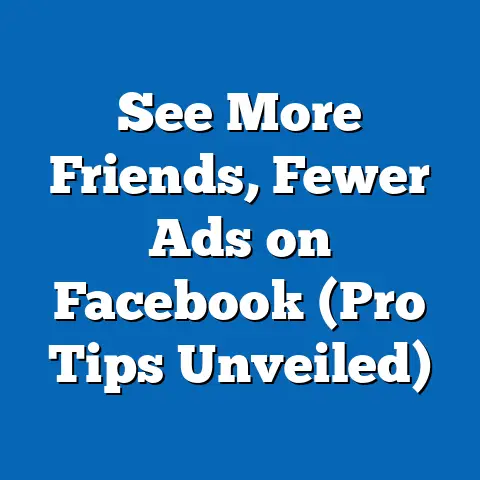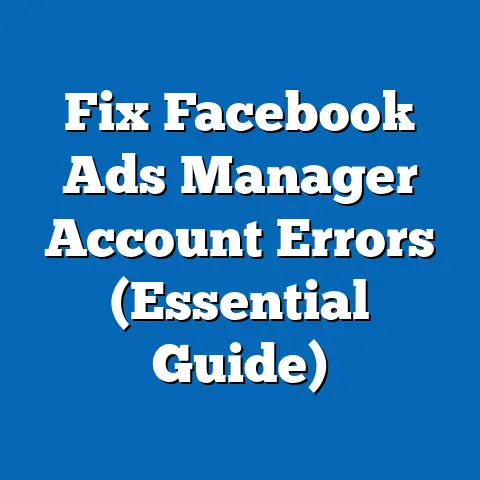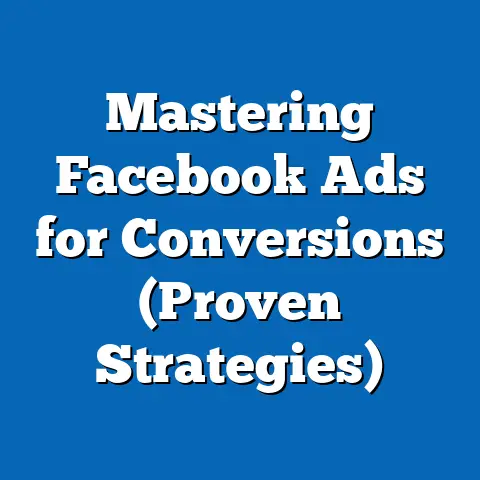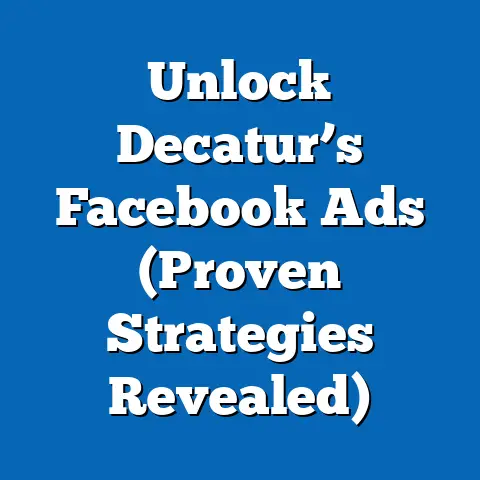Create Effective Spanish Facebook Ads (Proven Strategies)
In today’s digital landscape, reaching diverse audiences through targeted advertising is more accessible than ever, and Spanish-language Facebook ads offer a powerful opportunity for businesses to connect with a vast and growing demographic. With over 2.9 billion monthly active users on Facebook as of 2023 (Statista, 2023), the platform remains a dominant force in social media marketing. For advertisers targeting Spanish-speaking audiences, the potential is immense, as Spanish is the second most spoken language globally, with over 460 million native speakers (Ethnologue, 2023).
The ease of creating targeted ads on Facebook, combined with its sophisticated tools for language and demographic segmentation, makes it an ideal platform for crafting effective Spanish-language campaigns. This article will explore proven strategies for creating impactful Spanish Facebook ads, backed by data, trends, and actionable insights. From understanding audience demographics to leveraging cultural nuances, we’ll break down the key elements that drive engagement and conversions.
The Growing Importance of Spanish-Speaking Audiences
Demographic Insights and Market Potential
The Spanish-speaking population represents a significant and growing market for advertisers. In the United States alone, there are over 62 million Hispanic individuals, making up 18.9% of the total population (U.S. Census Bureau, 2022). This demographic is not only large but also digitally active, with 79% of Hispanic adults using social media platforms like Facebook (Pew Research Center, 2022).
Globally, Spanish-speaking countries in Latin America and Spain contribute to a massive online audience, with countries like Mexico (over 93 million Facebook users) and Colombia (over 39 million users) ranking among the top in user base (DataReportal, 2023). These numbers highlight the immense potential for businesses to tap into this market through targeted Spanish-language advertising.
Trends in Digital Engagement
The digital engagement of Spanish-speaking audiences has surged in recent years. According to a 2022 report by Hootsuite, Latin America has one of the highest social media penetration rates globally, with 74% of the population actively using platforms like Facebook. Additionally, mobile usage dominates in these regions, with 85% of Facebook access occurring via smartphones (DataReportal, 2023).
Historically, Spanish-speaking audiences were often underserved by digital advertising due to language barriers and lack of cultural relevance. However, with advancements in ad targeting and translation tools, businesses can now create highly personalized campaigns. Comparing this to a decade ago, when only 30% of U.S. Hispanic consumers reported seeing culturally relevant ads (Nielsen, 2013), today’s landscape shows a marked improvement, with 62% acknowledging better representation in digital marketing (Nielsen, 2022).
Why Spanish-Language Ads Matter: Cultural and Linguistic Relevance
The Impact of Language on Engagement
Language plays a critical role in advertising effectiveness. A 2021 study by Common Sense Advisory found that 65% of consumers prefer content in their native language when making purchasing decisions, even if they are bilingual. For Spanish-speaking audiences, ads in Spanish not only increase comprehension but also build trust and emotional connection.
In the U.S., while many Hispanics are bilingual, 71% report feeling more connected to brands that advertise in Spanish (Google/Ipsos, 2021). This trend underscores the importance of tailoring content to linguistic preferences rather than relying solely on English-language campaigns.
Cultural Nuances and Consumer Behavior
Beyond language, cultural relevance is a cornerstone of effective advertising. Spanish-speaking audiences are not a monolith; they encompass diverse cultures from Mexico, Central America, South America, the Caribbean, and Spain, each with unique traditions and values. For instance, a campaign targeting Mexican consumers might resonate more with imagery and messaging tied to cultural events like Día de los Muertos, while a campaign for Puerto Rican audiences might focus on local slang and holidays like Three Kings Day.
Failing to account for these differences can lead to disengagement or even backlash. A 2020 survey by ThinkNow revealed that 58% of Hispanic consumers in the U.S. feel misrepresented in advertising due to stereotyping or lack of cultural understanding. Thus, successful Spanish Facebook ads require a deep understanding of cultural contexts.
Key Strategies for Crafting Effective Spanish Facebook Ads
1. Audience Segmentation and Targeting
Facebook’s robust advertising platform allows for precise audience segmentation, a critical first step in creating effective Spanish-language ads. Start by defining your target demographic based on location, language preferences, and cultural interests. For example, you can target Spanish speakers in the U.S. by selecting language settings or geographic areas with high Hispanic populations, such as California (38.4% Hispanic) or Texas (39.7% Hispanic) (U.S. Census Bureau, 2022).
Additionally, leverage Facebook’s interest-based targeting to connect with users interested in Spanish-language content, such as Latin music, telenovelas, or soccer. Data from Facebook Ads Manager shows that campaigns with hyper-specific targeting achieve up to 30% higher click-through rates (CTR) compared to broader campaigns (Facebook Business, 2022).
Visualization Description: A bar chart comparing CTRs for ads with language-specific targeting (e.g., Spanish-only) versus non-targeted ads could illustrate the effectiveness of segmentation, showing a clear spike in engagement for tailored campaigns.
2. Crafting Compelling Ad Copy in Spanish
Writing ad copy in Spanish requires more than just translation; it demands localization to reflect regional dialects and colloquialisms. For instance, the word for “car” varies across regions—“carro” in Mexico, “coche” in Spain, and “auto” in Argentina. Using the wrong term can alienate your audience or make the ad feel inauthentic.
Work with native speakers or professional translators to ensure accuracy and cultural relevance. A 2019 study by Unbounce found that localized ad copy improves conversion rates by 22% on average. Additionally, keep your messaging concise and action-oriented, using strong calls-to-action (CTAs) like “¡Compra ahora!” (Buy now!) or “¡Descubre más!” (Discover more!).
3. Visual Storytelling with Cultural Resonance
Visuals are a powerful tool in Facebook ads, often determining whether a user stops scrolling. For Spanish-speaking audiences, incorporate imagery that reflects cultural identities, such as family gatherings, traditional foods, or national symbols. A 2021 report by Sprout Social found that ads with culturally relevant visuals achieve 40% higher engagement rates among Hispanic audiences.
Moreover, ensure that visuals are mobile-optimized, as most Spanish-speaking users access Facebook via smartphones. Use bright colors, clear text overlays, and vertical formats (e.g., 9:16 for Stories) to maximize impact. Testing different visuals through A/B testing can also help identify what resonates most with your audience.
Visualization Description: A pie chart showing the breakdown of engagement metrics (likes, shares, clicks) for ads with culturally relevant visuals versus generic imagery could highlight the importance of tailored content, with a significant portion attributed to cultural resonance.
4. Leveraging Video Content for Higher Engagement
Video ads consistently outperform static images on Facebook, with 59% of users more likely to engage with video content (HubSpot, 2022). For Spanish-language campaigns, create short, engaging videos with subtitles to accommodate users who watch without sound. Incorporate storytelling that reflects cultural values, such as community, family, or celebration, which are often central to Hispanic cultures.
Data from Facebook Insights indicates that videos under 15 seconds have a 66% higher completion rate among mobile users (Facebook Business, 2023). Pair this with Spanish voiceovers or text to ensure accessibility and relevance. Brands like Coca-Cola have successfully used this strategy, creating Spanish-language video campaigns for events like Hispanic Heritage Month, resulting in a 25% increase in brand favorability among Hispanic consumers (Nielsen, 2021).
5. Timing and Frequency for Optimal Reach
Timing is crucial for maximizing the reach of your Spanish Facebook ads. Analyze when your target audience is most active on the platform. For instance, DataReportal (2023) notes that Latin American users are most active between 7 PM and 9 PM local time, while U.S. Hispanic users often engage during lunch hours (12 PM–2 PM) and evenings.
Additionally, avoid ad fatigue by limiting frequency. Facebook recommends a frequency cap of 1.5–2 impressions per user per week to maintain engagement without overwhelming your audience (Facebook Business, 2022). Use the platform’s analytics to monitor performance and adjust scheduling as needed.
6. Budgeting and Bidding Strategies
Effective budgeting is key to a successful ad campaign. Start with a small test budget to gauge audience response before scaling up. According to WordStream (2023), the average cost-per-click (CPC) for Facebook ads in Latin America is $0.12, significantly lower than the global average of $0.97, making it a cost-effective market for experimentation.
Use Facebook’s automatic bidding to optimize for conversions or clicks, and allocate a higher budget to high-performing demographics. For example, targeting younger Hispanic users (ages 18–34), who make up 60% of the U.S. Hispanic social media audience (Pew Research Center, 2022), may yield better ROI due to their high engagement rates.
Measuring Success: Key Metrics and Analytics
Tracking Engagement and Conversion Rates
To evaluate the effectiveness of your Spanish Facebook ads, focus on key performance indicators (KPIs) such as CTR, conversion rate, and cost-per-acquisition (CPA). According to HubSpot (2023), the average CTR for Facebook ads across industries is 0.9%, but language-specific campaigns often see rates as high as 1.2% when properly targeted.
Use Facebook Ads Manager to track these metrics in real time, and segment data by demographic to identify which groups respond best. For instance, a campaign targeting Mexican-American users might show a 15% higher conversion rate compared to a broader Hispanic audience, signaling the need for more localized content.
A/B Testing for Continuous Improvement
A/B testing is a proven method to refine your ads. Test variations in copy, visuals, CTAs, and targeting to determine what drives the best results. A 2022 study by Optimizely found that businesses using A/B testing on social media ads see a 30% improvement in ROI on average.
For Spanish-language ads, test regional language differences or cultural themes to see which resonate most. Continuously iterate based on data to optimize performance over time.
Visualization Description: A line graph tracking the performance of two ad variants (e.g., Variant A with Mexican slang vs. Variant B with neutral Spanish) over a 30-day period could visually demonstrate the impact of localization, with Variant A showing a steeper upward trend in engagement.
Challenges and Pitfalls to Avoid
Language and Cultural Missteps
One of the biggest challenges in creating Spanish Facebook ads is avoiding linguistic and cultural errors. Direct translations often fail to capture the intended meaning, and cultural insensitivity can damage brand reputation. For example, a poorly translated ad by a major brand in 2018 led to a 10% drop in engagement among Hispanic users due to perceived mockery (ThinkNow, 2018).
To mitigate this, invest in cultural consultants or native speakers to review content before launch. Additionally, avoid overgeneralizations about Hispanic culture, as diversity within the community means one-size-fits-all approaches rarely work.
Budget Overruns and Inefficient Targeting
Another common pitfall is inefficient budget allocation due to overly broad targeting. Without proper segmentation, ads may reach users outside your intended audience, wasting resources. Data from WordStream (2023) shows that poorly targeted campaigns can increase CPA by up to 50%.
Regularly review analytics to ensure your budget is directed toward high-performing segments. Adjust targeting parameters if you notice low engagement or high bounce rates.
Case Studies: Successful Spanish-Language Campaigns
Case Study 1: Verizon’s Hispanic Heritage Month Campaign
In 2021, Verizon launched a Spanish-language Facebook ad campaign during Hispanic Heritage Month, targeting U.S. Hispanic users with culturally relevant video content. The campaign featured stories of Hispanic entrepreneurs and used the hashtag #Adelante to inspire community pride. According to Verizon’s internal data, the campaign achieved a 35% higher engagement rate compared to their standard ads, with a 20% increase in website traffic from Hispanic users (Verizon, 2021).
This success highlights the importance of aligning campaigns with cultural events and using authentic storytelling to build emotional connections.
Case Study 2: Coca-Cola’s Regional Targeting in Latin America
Coca-Cola’s 2022 campaign in Latin America used region-specific Spanish dialects and imagery to target users in Mexico, Argentina, and Colombia. By tailoring visuals to local festivals and slang, the brand saw a 28% increase in ad recall and a 15% boost in purchase intent compared to their previous generic campaigns (Nielsen, 2022).
This case underscores the value of localization in driving engagement and brand loyalty among diverse Spanish-speaking audiences.
Broader Implications and Future Trends
The rise of Spanish-language advertising on Facebook reflects a broader shift toward inclusive, culturally relevant marketing. As the global Spanish-speaking population continues to grow—projected to reach 500 million native speakers by 2030 (Ethnologue, 2023)—businesses must prioritize language and cultural strategies to remain competitive.
Emerging trends, such as the integration of AI for real-time ad localization and the increasing popularity of interactive formats like Facebook Stories, offer new opportunities to engage audiences. Additionally, as younger generations of Hispanic users become a larger share of the market, brands will need to adapt to their preferences for authenticity and social impact in advertising.
In conclusion, creating effective Spanish Facebook ads requires a blend of data-driven targeting, cultural sensitivity, and creative storytelling. By leveraging the strategies outlined in this article—segmentation, localization, visual storytelling, and continuous optimization—businesses can unlock the full potential of this dynamic and diverse audience. As the digital landscape evolves, those who invest in understanding and connecting with Spanish-speaking consumers will be best positioned for long-term success.






